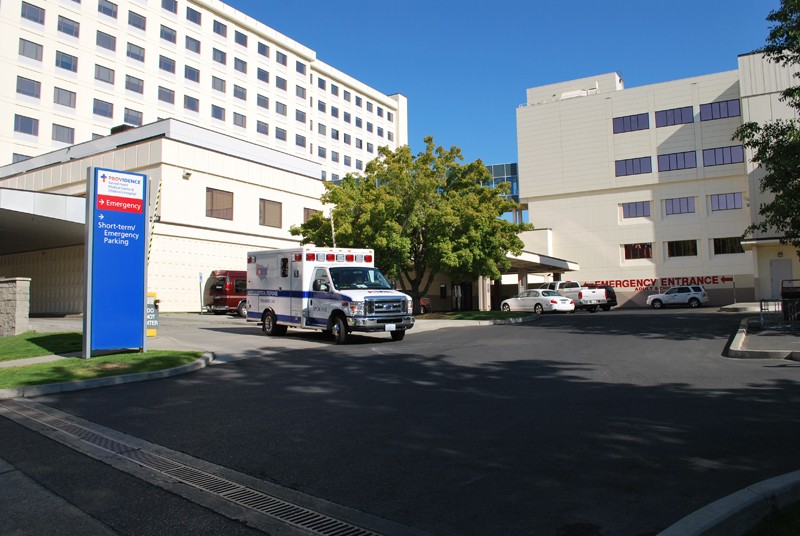It’s the biggest hospital in Eastern Washington, and a quick look at a few statistics will tell you why: Each year, Providence Sacred Heart sees about 80,000 patients — and that’s just in the emergency room. If you break the ER numbers down a little more, it’s even more amazing: 6,666 patients a month; 222 patients a day; a new patient about every six minutes.
And among all those patients, there are some who really shouldn’t be in the ER. It’s not necessarily that they don’t need to see a doctor. The problem is that too often there’s no actual emergency. But the fact is, for many people, the emergency room is their only choice for primary care.
For the past five years, Health For All, a Spokane nonprofit, has worked to help people find other solutions for their medical needs via the Emergency Room Diversion Program. Now, via a new grant, they’ll have a part-time staffer work with patients to find health care solutions outside the ER.
“The Emergency Room Diversion Program seeks to break the cycle of the uninsured using emergency rooms for primary care,” says Dan Baumgarten, recently retired executive director for Community-Minded Enterprises, the nonprofit agency that runs Health For All.
Estimates are that up to 20 percent of the patients seen in emergency rooms don’t have any insurance, but getting a handle on the problem is difficult.
“It is quite large in Spokane as well as in most metropolitan areas throughout the country,” says Ray White, HFA’s director. Health For All works with “people to find a form of coverage that they are eligible for, be that Medicaid or an inexpensive private plan,” says White. “The hope is that people will end up in a Medical Home [with a primary care provider/physician] and practice preventative care that will keep them from going to the ER for non-emergent medical issues.”
Meanwhile, Washington state is cracking down on non-emergent use of the ER by Medicaid recipients. In September, Washington became the first state to curtail use of the emergency room.
“Beginning October 1, 2011, Medicaid will only pay for three non-emergency visits to the Emergency Room per client per year. The fourth and subsequent non-emergency visits will not be covered by Medicaid, and clients may be billed for those services,” according to the Health Care Authority website. The move has been contested by physicians, who take issue with the state’s description of what constitutes an emergency.
“This list of non-emergent diagnoses puts patients in danger and unfairly targets the poor and those in most need of care,” says Stephen Anderson, president of the Washington Chapter of the American College of Emergency Physicians.
The state spent nearly $98 million on 327,965 fee-for-service Medicaid ER visits last year. The State Legislature estimates the new rules could save a third of that — about $35 million a year.
Additional reporting by Anne McGregor
MORE CARE FOR KIDS
In addition to the ER diversion program grant, Health for All also received a $300,000 federal grant to attempt to connect teenagers with health care assistance programs. Teenagers who are homeless, or living with friends or distant relatives, as well as kids whose parents may be overwhelmed or underinvolved have been a particularly hard group to reach, says the program’s resource manager Nina Kindem. The first step will be locating kids who have vanished from the state’s Medicaid program, called Apple Health for Kids. Kindem says sometimes people fail to recertify their kids for Medicaid because they don’t know how to overcome perceived obstacles, such as an agency’s request to attach a pay stub.
“They get paid by direct deposit, so they don’t have a pay stub,” she says. And the child loses coverage as a result.
Then the staff will work to connect kids with services. Kindem says the state’s new “benefits portal” will streamline the process. “It allows people to go online and look at their eligibility for programs — you can pick and choose what you want to target for application,” says Kindem, rather than filling out form after form for each type of need.
Kindem says many people are surprised to learn they qualify for at least some level of health care assistance. For example, a family of four can earn up to $5,588 a month and still qualify for children’s medical, dental, hospital, vision and prescription insurance coverage at a cost of just $30 per month per child.
“There’s a whole new population of people who don’t know anything about asking for services or what to expect,” says Kindem. “They have had a lifetime of employment where they look at these programs as ‘those people’ and now, they find themselves as one of ‘those people.’
“It is a great help to families to be able to mitigate their costs, and be able to afford things like food.”
— Anne McGregor
















